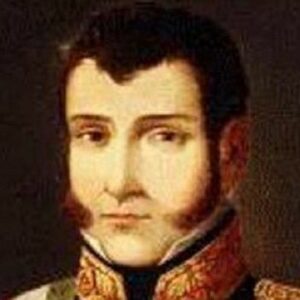Agustin de Iturbide was a Mexican revolutionary and the leader of the conservative faction of the Mexican independence movement who served as Emperor of Mexico for a short time. Iturbide began his military career as a royalist lieutenant. Rather than joining his cousin Costilla’s insurgent army, he remained faithful to the Spanish cause and promised to serve the same. His outstanding defense of Valladolid against revolutionary forces led to his appointment as commander of the Guanajuato and Michoacán military districts. The Plan de Iguala, published on February 24, 1821, was Iturbide’s most significant contribution. He came up with three ideas as a result of it: immediate independence from Spain, equality for Spaniards and Creoles, and Roman Catholicism as the exclusive religion with all other religions outlawed. He was crowned Emperor of Mexico in 1822. His rule did not endure more than a year, however, as he failed to maintain peace and stability. Furthermore, Iturbide was dethroned and eventually exiled due to opposition from all parties. Later, he was kidnapped and executed. Iturbide is regarded as one of the great heroes of the Mexican independence movement, despite his failure as Emperor of Mexico.
Childhood and Adolescence
Agustin I was born in Valladolid, Michoacan, on September 27, 1783, as Agustn Cosme Damian de Iturbide y Arámburu parents José Joaqun de Iturbide y Arregu and Mara Josefa de Arámburu y Carrillo de Figueroa. He was the family’s fifth and only male heir.
Agustin studied in the Colegio de San Nicolás in Valladolid, a Catholic seminary with a terrible academic record. Later, he enrolled in a secular officials’ program.
Career of Agustín de Iturbide
Agustin de Iturbide enlisted as a Criollo in the royalist army while he was in his teens. In 1806, he was promoted to full lieutenant after serving as a second lieutenant in the provincial regiment.
His military fame expanded by leaps and bounds. His bold demeanor, chivalrous demeanor, unrivaled horsemanship, and military aptitude earned him the title of ‘The Iron Dragon’ of the royalist army. For the Insurgents, he became a dreaded name.
Miguel Hidalgo y Costilla offered him a position in his revolutionary army after the commencement of the War of Independence in 1810, but Iturbide declined and instead committed to serving for the Spanish cause. He remained a member of the royalist army.
He fought against general José Mara Morelos in his hometown of Valladolid from 1810 to 1816 during the conflict. He successfully defended the city and forced the insurgents to withdraw due to his subtle approach and horse-riding talents. He was promoted to captain as a result of his triumph.
Iturbide pursued the rebels as a captain, eventually apprehending Albino Licéaga y Rayón. In 1813, his valor earned him another promotion, this time to colonel. He was the main military opponent of Morelos from 1813 to 1815, primarily in charge of the military districts of Guanajuato and Michoacán. His pursuit came to an end in 1815, when he seized and executed Morelos.
Iturbide was expelled from the royalist forces in 1816 after being charged with extortion and assault. He was chastised for being abusive to citizens and for acting in an arbitrary manner. He was also accused of acquiring significant business assets and misappropriating military monies.
Iturbide was reinstated to the military command in November 1820, as a colonel for the royalist forces, after successfully annulling all charges against him with the help of his auditor.
The Mexican independence movement took a typical U-turn in the 1820s. The conservatives demanded immediate independence, prompting Iturbide to take leadership of the army and align his reactionary forces with Guerrero’s extreme insurgents.
Iturbide forged a combination of Mexican liberal revolutionaries, landed nobility, and the church after becoming convinced that independence for Mexico would give security against the republican side.
He devised the Iguala Plan, which was based on three major principles: immediate independence from Spain, equality for Spaniards and Creoles, and Roman Catholicism’s primacy over all other religions. The proposal gained traction because it sought independence while avoiding social disintegration.
The Treaty of Córdoba was signed on August 24, 1821, by Juan O’Donoj, the new envoy of the Spanish king, recognizing the independence of New Spain under the Bourbon dynasty.
Iturbide was chosen Emperor of the Mexican nation in 1822. On July 1, 1822, he was crowned at the Mexico City Cathedral.
The Catholic clergy were thrilled with Iturbide’s crowning, but the republicans were not. Congress proved to be his most vehement foe. Despite his charisma, Iturbide was generally unsuccessful in restoring order and stability to the country.
Iturbide’s opposition grew stronger under Santa Anna’s Plan de Veracruz, which called for the reinstatement of the old Constituent Congress by December 1822.
Iturbide abdicated on March 19, 1823, and moved to Italy first, then England. He returned to Mexico with his family the following year, unknowing that the Congress had ordered his execution. He was first well-received, but he was later apprehended and hanged.
Personal History and Legacy
In the year 1805, Agustin I married Ana Mara Josefa Ramona de Huarte y Muiz. The couple had a total of ten children together.
The firing squad executed Agustin on July 19, 1824. His body was buried after he was executed. The parish church of Padilla had abandoned it until 1833, when then-President Santa Anna rehabilitated Iturbide by transporting his remains to the capital with state honors.
His ashes were interred in an urn in the Chapel of San Felipe de Jesus at Mexico City Cathedral on October 27, 1839.
Estimated net worth
The estimated net worth of Agustín de Iturbide is unknown.


